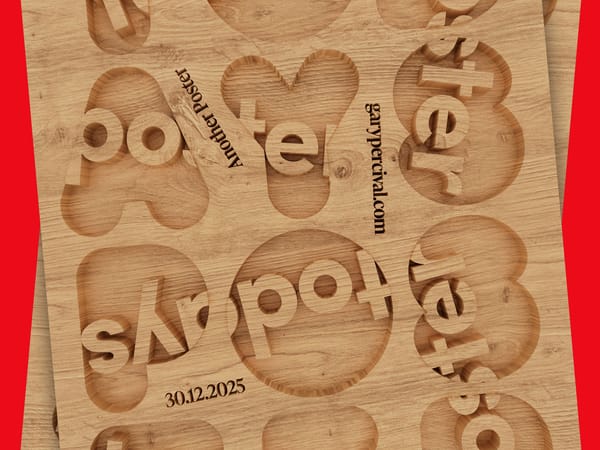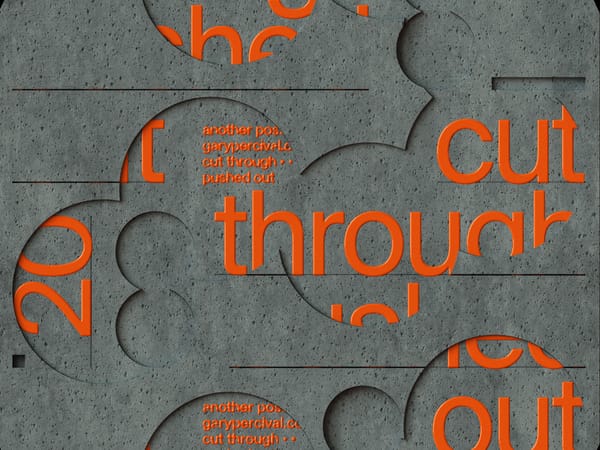The Invisible Critics Blocking Your Boldest Work
"You didn’t get rejected—you just imagined the criticism and let it guide your hand."

You’re staring at a concept that feels risky. A piece of work that breaks from your usual style. A design that says exactly what you mean.
And just before you share it, a question creeps in:
“What will they think?”
So, you tone it down. You tweak the edges. You smooth the sharp corners. You shrink the idea until it feels… safer.
But here’s the catch: you didn’t get feedback. You didn’t get rejected. You didn’t even ask.
You imagined the criticism—and still gave it veto power.
These are the invisible critics. And they might be stopping your boldest, most original work from ever seeing the light of day.
Who Are the Invisible Critics?
Invisible critics are the voices in your head that show up the moment you try to do something different, honest, or daring.
They’re not real people. Not really.
They’re a fuzzy blend of:
- Former teachers.
- Grumpy clients.
- Social media strangers.
- Imaginary design gatekeepers.
- That one negative comment you got three years ago.
They live in your head. You consult them without meaning to. You imagine their reactions—and still give them the final say.
They don’t ask questions. They just whisper things like:
- “This is too much.”
- “Who do you think you are?”
- “You’ll lose followers over this.”
- “Your peers will judge you.”
- “This isn’t what people expect from you.”
- “Don’t mess this up.”
The Critics You Invent Are Often Harsher Than Reality
Here’s the irony: the real world is rarely as critical as the one in your head.
Clients don’t comb through every pixel.
Peers don’t scrutinise your every word.
Strangers aren’t waiting to tear you down.
In fact, most people:
- Aren’t paying as much attention as you think.
- Are more supportive than you expect.
- Are too busy battling their own invisible critics to critique you.
And even when feedback does come, it’s often helpful—not hostile. But because we’ve already played out worst-case scenarios in our minds, we brace for impact that never arrives.
How the Invisible Critics Show Up
Even if you can’t hear them directly, you can spot their influence in your work. Here’s what it looks like:
Self-Censorship Before You Start
You filter your ideas before they even hit the page. You dismiss the risky ones. You go with what’s been done before—because it feels “right” (aka safe).
Endless Tweaking
You over-edit and over-refine, not to improve the work, but to preempt criticism. The result? Sterile, lifeless output that no longer feels like you.
Avoiding Visibility
You delay posting your work. You skip the pitch. You hide your in-progress experiments—because someone might think something negative.
Creative Inconsistency
You keep reinventing your style, second-guessing what you’re “supposed” to make. Instead of growing into your voice, you water it down for imagined approval.
If any of this sounds familiar, you’re not broken. You’re just letting fictional critics steer real decisions.
Why We Listen to Voices That Aren’t Even Real
Creativity and vulnerability are inseparable. Every time you share an idea, you’re offering up a piece of how you see the world. That’s scary.
Your brain wants to protect you. So it builds stories.
And in those stories, it’s safer to please a phantom critic than to risk rejection. It’s easier to imagine being laughed at than to be ignored. It’s more comfortable to retreat than to boldly move forward.
But that protection comes at a cost.
The Cost of Playing It Safe
Your invisible critics aren’t just annoying. They’re expensive.
They cost you:
- Originality – You default to what’s been done, not what you believe.
- Opportunities – You don’t share the work that might actually get noticed.
- Momentum & Confidence – You hesitate so often, you miss chances to move forward.
- Joy – You forget why you started creating in the first place.
In trying to avoid judgement, you trade the very thing that makes creative work powerful: boldness.
How to Spot—and Silence—Your Invisible Critics
You can’t eliminate self-doubt. But you can turn down the volume. Here’s how to start.
Name Them
When that voice shows up, don’t let it stay vague. Give it a name.
Is it “Perfectionist Pete”?
“Cynical Claire”?
“Design Twitter’s Worst-Case Scenario”?
Naming the voice turns it from authority into character. Something you can observe, not obey.
Ask: Who’s Actually Watching?
When you catch yourself shrinking your idea, ask: Who am I afraid of?
Can you name a real person? A specific consequence?
Often, there’s no clear answer—just a cloud of imagined judgement. That’s your cue: this isn’t feedback. It’s fear in disguise.
Return to Your Why
The invisible critics focus on reactions. You need to focus on intentions.
Why are you creating this?
What are you trying to say?
Who is this for?
Anchor yourself in purpose, not approval.
Publish Anyway
The longer you sit with fear, the louder it gets. The fastest way to quiet your inner critic? Take action.
Post the idea. Share the draft. Show the sketch.
Once you realise you survived, the fear shrinks. The critic gets quieter. You remember: it was never that dangerous.
Collect Evidence
Start tracking when your fears were wrong.
- The time you posted something bold—and got compliments.
- The moment you tried a new style—and landed a client.
- The time you raised your rates—and no one blinked.
Evidence rewires belief. Keep the receipts.
A Note to the Creative Perfectionist
If you’re holding back because you want to be proud of your work, that’s a good instinct.
But being proud doesn’t mean being perfect.
It means being honest. Bold. Brave.
Your best work probably won’t come from trying to impress everyone. It will come from making something so you that no one else could have made it.
And yes—that kind of work might not land with everyone.
But the right people? The ones you actually want to reach? They’ll feel it.
But only if you share it.
You Are Not Obligated to Obey a Voice You Invented
Let’s make this clear:
The voice that says “this is too much” is yours.
The one that whispers “don’t risk it”? Also yours.
You don’t owe those voices your obedience.
You don’t have to make decisions based on fictional reactions from invisible people.
You’re allowed to trust your instincts.
You’re allowed to make something unapologetic.
You’re allowed to be proud before anyone else approves it.
And you’re allowed to hit publish—even if your inner critic is still mid-sentence.
Final Thought: Who Would You Be Without That Voice?
Imagine creating something without the imaginary commentary.
Imagine sharing your work without rehearsing rejection.
Imagine being led by curiosity instead of criticism.
That version of you?
They’re not smarter.
Not more talented.
Just less obedient to that voice.
That’s where boldness begins.



